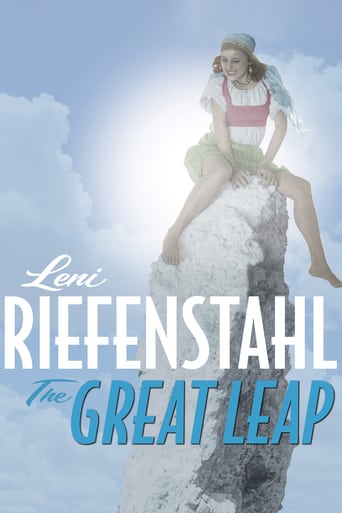FerdinandVonGalitzien
Frau Gita ( Frau Leni Riefenstahl ) is a young and healthy Italian shepherdess fraulein that lives in the Alps. Besides caring for her little brothers and sisters, she has a goat called Pippa that she also cares for a lot. It is probably because of Pippa that she likes climbing mountains all day so very much. This hobby isn't particularly shared with Herr Toni ( Herr Luis Trenker ) a friend who lives nearby and who prefers to wear typical shepherd's customary garb ( hat with feather included ) instead of going up and down the Dolomites. During an unexpected visit to the mountains by Herr Michel Treuherz ( Herr Hans Schneeberger ) – who is an idle, rich and clumsy Berliner – and his valet Herr Paule ( Herr Paul Graetz ), funny situations will happen all around."Der Grosse Sprung", a film directed by Herr Arnold Fanck in the silent year of 1927, is a "mountain film" of that specific German film genre very popular during the 20's in Deutschland. It's a picture that contains all the typical and particular film resources that any "mountain film" must have. That is to say, it is a simple and schematic story full of topics in which nature and the beautiful mountain landscapes are the true main characters of the movie. (Let's not forget also that in many "mountain films" there is a special place for winter sports. Snow skiing is especially included in many of those pictures complete with a thrilling downhill skiing competition at the end of the film.)On behalf of the mountain film genre, it must be said that those pictures have excellent cinematography ( six cinematographers were needed in "Der Grosse Sprung"! ). This enhances and idealizes the landscapes where the story of the film is based ( aestheticism über alles! ). Memorable too is the skillful and creative editing involved in the inevitable "mountain film" skiing competition. So in "Der Grosse Sprung", there is obviously one in the final part of the movie. It's brilliantly developed, full of rhythm ( the camera filming almost from every impossible angle ) and complete with comic situations. Unfortunately, it is excessively long (which is an unfortunate lack in many "mountain films").Concerning the mountain films genre, it must be said that those pictures included a shameful collection of topics ... folkloric interests and stereotypes that many times make this Herr Von blush ( a terrible fact this indeed, such momentary aristocratic pallor ). It happens in "Der Grosse Sprung" that Frau Gita and Herr Toni wear picturesque clothes from an Italian catalogue resulting in somewhat less than impressive performances. At this point this Herr Graf must give the credit to the characters of Herr Treuhez and his valet who are outstanding in the film and a notch above the others actors. The two characters give to the film hilarious scenes as the typical clumsy city ( and rich ) idle boy put into completely different surroundings and his valet, an efficient servant who will help his master as much as he can in spite of dangerous and freezing situations. It must be said that the fundamental principle of any "mountain film" is to entertain in a basic, even naïve way, paying more attention to the snow skiing action scenes and the outstanding landscapes while, not caring at all for a complicated plot. So, finally the artistic aim justifies the means.Participating in "Der Grosse Sprung" were the mountain film classic triplet, Frau Leni Riefenstahl, Herr Arnold Fanck und Herr Luis Trenker. These were very important and strong personalities and that's necessary in order to understand this German film genre. They coincided and collided many times during their works together, later to develop different artistic routes. Frau Leni Riefenstahl became the most important of the three and a controversial, tricky but at the same time, fundamental figure of German and world cinema history.And now, if you'll allow me, I must temporarily take my leave because this German Count must ask for the doctor in order to cure a few aristocratic broken bones after alpine skiing.


